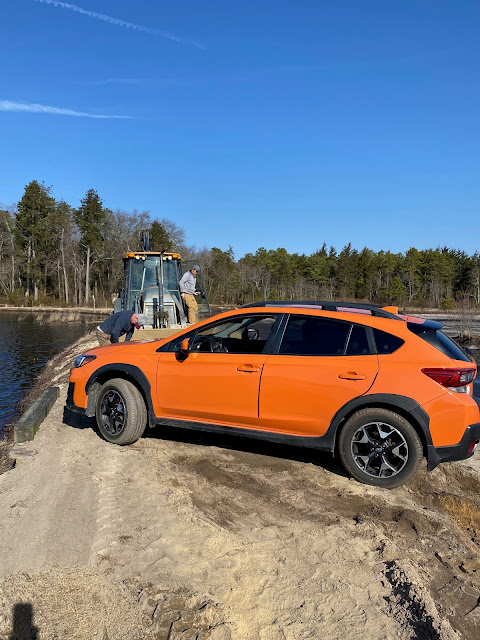 |
Sandhill Cranes, Bombay Hook
Photo: Shari Zirlin |
Shari & I spent a good part of the week in Delaware and despite some dreary weather, we did pretty well. We left late Tuesday morning in a persistent rain that continued all the way to Smyrna. But just as we turned onto to Whitehall Neck Road, about 2 1/2 miles from Bombay Hook, the rain stopped. About a mile up the road we saw a few
Killdeer and then a couple of
Horned Larks feeding the on the road and then we got our official greeting when about 5000
Snow Geese descended onto the sodden potato fields. I know, because I kept seeing reports, that there was a Ross's Goose (I'll be glad to lose
that eponym with the orthographically silly s's) in with them, but I wasn't about to spend hours sorting through the flock which pulsated like a gigantic living organism.
 |
| Short-eared Owl, Bear Swamp Pool |
Once inside the refuge proper we stopped to admire the new, very attractive, large Visitor's Center (hint, hint, Forsythe), and then started around the impoundments. Waterfowl, as you would expect in late winter, prevailed. No shorebirds, as the water levels were ridiculously high--areas that are usually marshy showed only the tips of the reeds and grasses breaking through the water. And the tide appeared high on the bayside too. We scored our first year bird with a
Tree Swallow flying over Shearness Pool. We found what we would expect at Raymond Pool and Shearness--lots of eagles, ho hum, and then we started making our way around Bear Swamp Pool, hoping for the Glossy Ibis that had been seen there for what seemed like the last month as I read the rare bird reports for Kent County. The joke about Bear Swamp Pool as always been NO bear, NO swamp, and since it is usually just mud, NO pool, but like everything else in Delaware, this time the impoundment was flooded--
Common Mergansers had no problem diving into its depths. Naturally, the last report of the ibis was on the 4th. Here on the 5th, nothing. But then Shari suddenly stopped the car, cussed, and told me to get out the scope. Just as I was pulling it out of the back seat, she cussed again, and I looked up to see a
Short-eared Owl fly away from us onto a dead tree in the middle of the pool. Shari was disappointed that it wasn't as close as when she first spotted it, but with the scope we had very good looks, especially of its back, though it did rotate its head to give a couple of facial views. I took some digiscope photos, proving how perfectly camouflaged these owls can be. Not only was that a year bird for us, but it was our first Delaware Short-eared Owl.
We spent a little under 3 hours there, leaving as it was started to get darker. We were amused to find one Wild Turkey crossing and recrossing the road to Finis Pool as if it couldn't make up its mind, and then just beyond the refuge gate, we had 7 more toms cross the road and run up a lane between the fields and the refuge. 35 species for the few hours we were there.
Wednesday we weren't as lucky with the weather. The forecast was for rain in the afternoon, so our plan was to drive down to Mispillion and stand on the deck of the DuPont Nature Center, looking for shorebirds (read: oystercatchers), ducks, and what not. The forecast was optimistic. It started to rain a little about two miles from the center, and in earnest when we got there--a blowing, cold, nasty rain and DuPont has very little shelter--we stood under the eaves of the old lighthouse structure, but that doesn't help when the rain is horizontal. We did get Shari's oystercatchers, very briefly, a Black-bellied Plover, 7 eagles, ho-hum, gulls and let's get the hell out of here. The other part of our plan, which was to work our way north at some other spots, was obviously not going to work. We spent the rest of the day indoors.
Thursday was better. Overcast, colder than I like, but better. At Bear Swamp Pool we took a little walk along the trail toward the back of the impoundment, thinking that maybe the ibis was there (why I wanted to see an ibis so badly escapes me since in a month or so they'll be all over the place) but of course, that bird was long gone. We did hear another year bird though--our first Eastern Towhee calling "chwink!" in the woods. As we were heading back to the parking lot for lunch, just emerging from the woods, Shari stopped and pointed right--"There they are!" "They" were two Sandhill Cranes feeding in a big field a quarter mile from the Visitor's Center. Sandhill Cranes are apparently not flagged as "rare" anymore in Kent County--just "infrequent." "Elusive" might be a better word, since no one else seems to have seen them that day.
Friday was the best day weather-wise--sunny and seasonable. We drove down to Prime Hook. Prime Hook is harder to bird than Bombay Hook because it takes in so much more territory and requires a lot more driving. What we usually do, and did, is walk around the boardwalk area and the marsh trail, look at one of the ponds, and take a ride down to look at the Broadkill Marsh. But, because I noticed an interesting listing on eBird, we took a walk on a trail we'd never tried before--it was in an area with the rather convoluted designation Turkle Pond--pinewoods--Fleetwood Pond. We'd been to the ponds before, but never before walked the trail, which is less than a mile, and goes through a loblolly pine stand. Loblolly pines are the preferred (and for all I know, only) habitat of the Brown-headed Nuthatch. (It isn't hard to identify loblolly pines in Delaware--find a pine tree and it's a loblolly). To find Brown-headed Nuthatches, we have either gone to Cape Henlopen, we're you can track them down on a certain trail, or else on Big Stone Beach Road in Kent County (where the population there is flagged as rare) which was one of our abandoned stops on Wednesday. I had no idea they were present at Prime Hook. We walked along the trail for about quarter of a mile, and it was deadly quiet. Shari played the recording of the nuthatch, which really does sound as it is described, like a pet's squeak toy, but we got no response. On a spur off the main trail which leads to a wetland (where, because of the phragmites, we could see nothing) we heard, as we were heading back, the little squeak. Again. And again. And then persistently, one, then two. Shari played the recording again and called in a chickadee, but then, crawling down the pine tree head-first, just like a nuthatch should, we saw the brown-capped little bird. I have to say it was quite a thrill--there is something very satisfying about find a tiny bird in a big area. But it wasn't a Kent County bird--Shari was not sympathetic.
We did go down Broadkill Road to look at the marsh, but again, the water was very high, and there were no shorebirds--there was no mud or high spots for them, except for one sandbar, where I saw some gulls and smaller white birds. One was flying, and with the scope I could see that they were Forster's Terns (FOY), so not a totally wasted trip.
 |
Raymond Pool
Photo: Shari Zirlin |
Today, the weather again sucked. Overcast, and with a steady wind, making 45 degrees feel more like 35. Rain was supposed to start around noon. We went to Bombay Hook, intending to make a relatively quick trip around and then head back to New Jersey. Despite having seen some really good birds, I was still a little let down because we hadn't seen one of the Delaware specialties. That changed at Raymond Pool when Shari said that flock of birds that had just flown in looked like shorebirds, but they were too big. "Which means," I said, "they might be avocets." I didn't think I'd be scoping much in the wind, but to make sure of our identification, I pulled out the scope and got on the flock--180 American Avocets (give or take). The flock was very nervous, with good reason, as an eagle, ho-hum, was making its rounds over them. They would pick up and circle around the pool, then land, then do another touch and go. It didn't help for one of them as we saw the eagle flying off with an avocet in its talons. I love avocets in winter plumage--I think the high-contrast black-and-white coloration is much more appealing than the russet they have when they're breeding. As I was counting the avocets, Shari was whisper-yelling at me to come back to the car. "Hurry up, hurry up," (now
there's a switch, her telling me to hurry up). What she wanted me to see was the two Sandhill Cranes, feeding right in front of us in Raymond Pool. Again, I don't think anyone else reported them today.
The eagle taking the avocet was not the most dramatic eagle meal we saw this trip. Yesterday, before we finished for the day, we decided to take a drive down Port Mahon Road, which has to be the most dismal spot in Delaware, a rock-strewn unpaved road with derelict piers and utility poles in the middle of the road. But a good place to look for shorebirds, gulls, ducks, and so forth. Except maybe not in the winter, since there was virtually nothing there except for the usual gulls and, ho-hum, 4 eagles. We didn't bother going to the end of the road, since the place is a flat tire waiting to happen, but on our way out, on smooth macadam, a car was stopped in the middle of the road "What's he looking at?" As he was blocking the road, he drove off, but we stopped to see a vulture and an eagle standing on the side of the road, the eagle eviscerating a red fox. The vulture was just waiting for the eagle to finish. Eagles can kill a fox, but they'll usually go after easier prey, so this might be roadkill. The eagle dragged the fox around, looking for the tasty bits, I suppose. And the vulture just stood by.
Forgive me, but the English major in me is about to come out: T.S. Eliot, Nobel Prize-winning poet, had a concept he called the "objective correlative," in which, as I remember, an image stood for an emotion. Watching the eagle disembowel the fox was the objective correlative for Port Mahon Road.
For our 3 full days and 2 partial ones, we had 72 species. Not as many as I had hoped, but quality made up for quantity:
Species First Sighting
Snow Goose
Whitehall Neck Rd.
Canada Goose Bombay
Hook
Mute Swan Bombay
Hook
Tundra Swan Bombay
Hook
Wood Duck Bombay
Hook
Northern Shoveler Bombay
Hook
Gadwall Bombay Hook
Mallard Bombay Hook
American Black Duck
Bombay Hook
Northern Pintail Bombay
Hook
Green-winged Teal Bombay
Hook
Bufflehead Bombay
Hook
Hooded Merganser Bombay
Hook
Common Merganser Bombay
Hook
Ruddy Duck Bombay
Hook
Wild Turkey Bombay
Hook
Pied-billed Grebe Bombay
Hook
Mourning Dove
Whitehall Neck Rd.
Sandhill Crane Bombay Hook
American Avocet Bombay Hook
American Oystercatcher
DuPont Nature Center
Black-bellied Plover
DuPont Nature Center
Killdeer Whitehall
Neck Rd.
Greater Yellowlegs Bombay
Hook
Dunlin Bombay Hook
Bonaparte's Gull DuPont
Nature Center
Ring-billed Gull DuPont
Nature Center
Herring Gull DuPont
Nature Center
Great Black-backed Gull
DuPont Nature Center
Forster's Tern Prime Hook
Great Egret Bombay
Hook
Great Blue Heron Bombay
Hook
Black Vulture Dover
Turkey Vulture Bombay
Hook
Northern Harrier Bombay
Hook
Cooper's Hawk Prime
Hook
Bald Eagle Bombay
Hook
Red-shouldered Hawk
Prime Hook
Red-tailed Hawk Bombay
Hook
Short-eared Owl Bombay Hook
Belted Kingfisher Bombay
Hook
Red-bellied Woodpecker
Bombay Hook
Downy Woodpecker Bombay
Hook
Northern Flicker Bombay
Hook
American Kestrel Milford
Blue Jay Dover
American Crow Prime
Hook
Fish Crow Dover
Carolina Chickadee Bombay
Hook
Tufted Titmouse Bombay
Hook
Horned Lark
Whitehall Neck Rd.
Tree Swallow
Bombay Hook
Brown-headed Nuthatch Prime Hook
Carolina Wren Bombay
Hook
European Starling Dover
Gray Catbird Bombay
Hook
Northern Mockingbird
Bombay Hook
Eastern Bluebird Bombay
Hook
Hermit Thrush Prime
Hook
American Robin Bombay
Hook
House Sparrow Bombay
Hook
House Finch Bombay
Hook
American Goldfinch Bombay
Hook
Fox Sparrow Prime
Hook
White-throated Sparrow
Bombay Hook
Song Sparrow Bombay
Hook
Eastern Towhee Bombay Hook
Red-winged Blackbird
Bombay Hook
Common Grackle Bombay
Hook
Boat-tailed Grackle
DuPont Nature Center
Yellow-rumped Warbler
Bombay Hook
Northern Cardinal Bombay
Hook
















